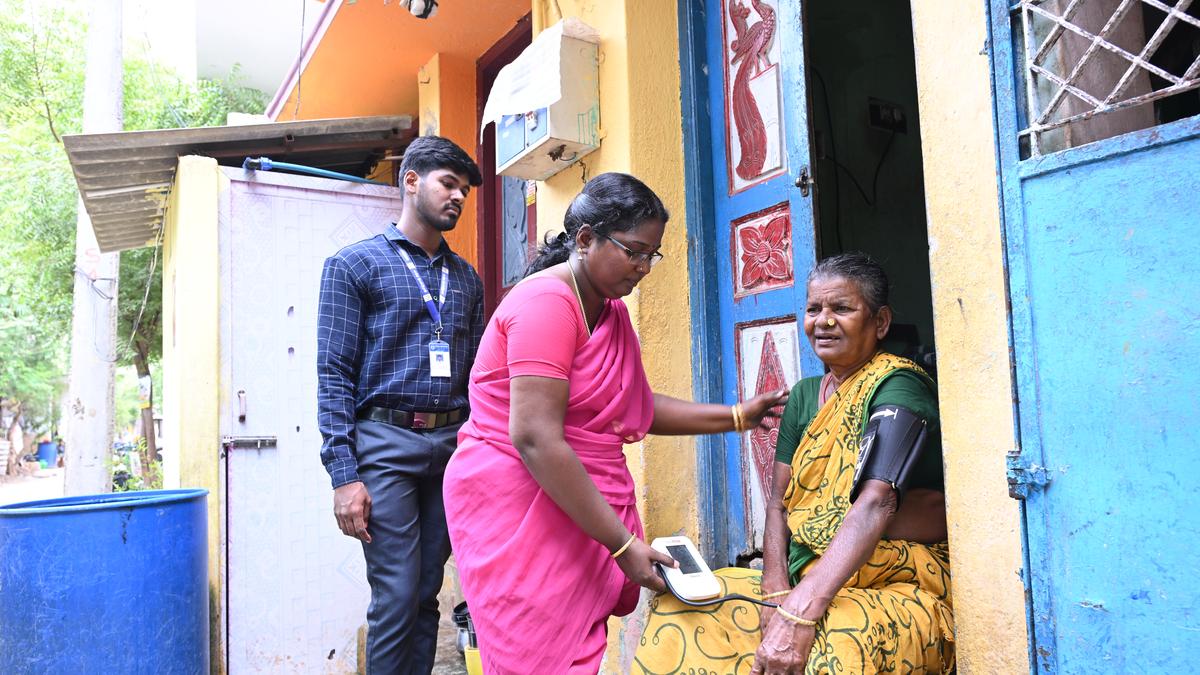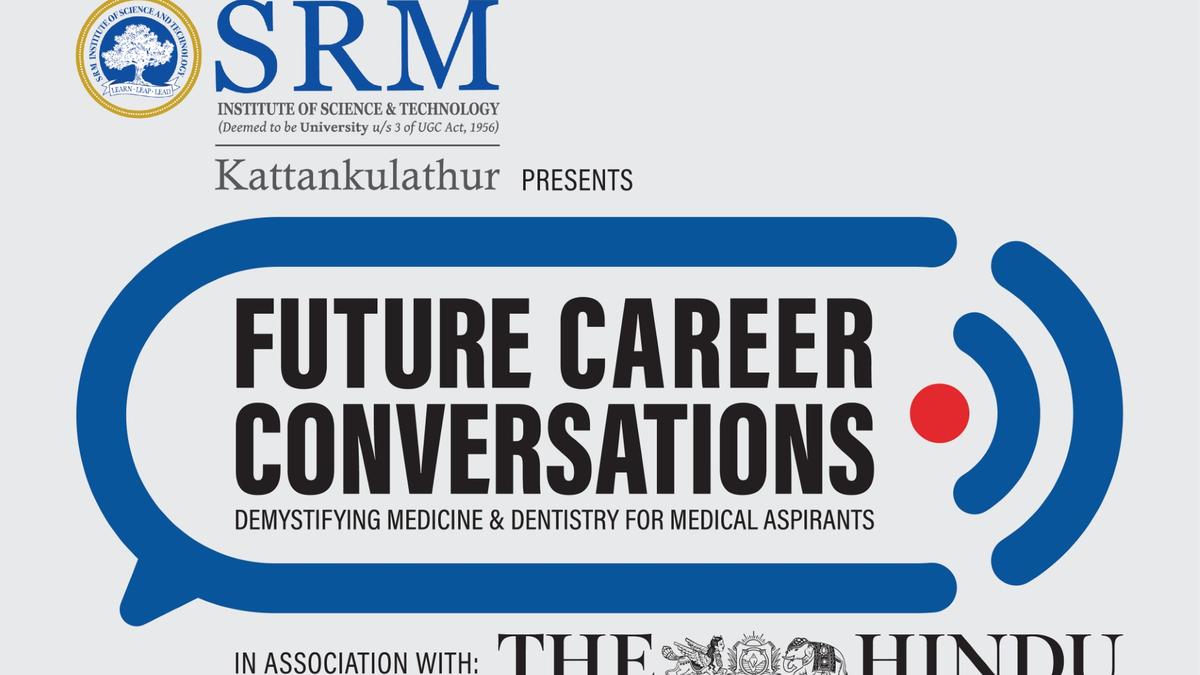S. Vasanthi, a diabetic, at Sakkimangalam in Madurai.
| Photo Credit:
R. ASHOK
A bed-ridden former ward member’s wife S. Vasanthi, 70, of Sakkimangalam, a Narikuravar community habitat in Madurai east taluk, lives on the diabetic medicines supplied by the Women Health Volunteers (WHVs) of Makkalai Thedi Maruthuvam (MTM), a novel initiative of the Tamil Nadu government.
For the widow, who lives in a shanty house made of plastic and torn bedsheets, if not for the two-months of medicines supply by MTM volunteers, her sugar level would shoot up endangering her life.
The MTM scheme has saved her life and penny; however, it has failed to identify any new diabetic person in the same locality.
Chinapaapa, 75, who lives alone in her hut in the same locality, says she was not tested nor has any health volunteer visited her to identify any health problems.
Her other neighbours, recollecting a health camp which was arranged at the village mid-point near a ration shop about a year ago, say they could not walk up to the camp as most of them were not informed or alerted earlier.
The prime aim of the MTM scheme started in 2021 was to enable home-based screening and drug delivery at the doorsteps of beneficiaries.
Though the scheme through its 20,000 workforce reportedly reached 5.50 crore individuals through screening – one crore first-time beneficiaries and 3.20 crore repeat – service beneficiaries – the actual follow-ups would be lesser, as per World Health Organization (WHO) data.
By focusing on Non-Communicable Diseases (NCDs) like diabetes, high blood pressure, psychological problems, mouth and breast cancer, Chronic Obstructive Pulmonary Disease (COPD) and Chronic Kidney Disease (CKD), the WHV, under the scheme, were mandated to visit every household falling under their jurisdiction and carry out the tests required for identification.
According to the Tamil Nadu State Planning Commission’s survey report on the MTM scheme, the scheme has halved the out-of-pocket medical expenditure for the lowest income groups.
The report added, “Before the scheme started operating, the poorest income group in the survey had to spend over 10% of their monthly family income on treatment of diabetes and hypertension. Once the scheme rolled out, spending on the treatment has more than halved.”
Though the scheme has recorded remarkable achievements like bringing the low-income population with diabetes and hypertension under the ambit of government record, keeping them in the government medication records, slowdown of the works owing to insufficient volunteers and irregular medicine supply have derailed the system in certain areas, if not all.
A WHV at Keelavalavu, requesting anonymity, pointed out the practical difficulties in achieving the assigned duty like dispensing hypertension, diabetes and other essential medications in colour coded paper bags and checking BP and blood glucose at the time of drug delivery at the households.
“Many a times, due to the workload coupled with the absence of essential drugs and devices, people will be asked to visit nearby health centres like PHC, Health Sub-Centre or Community Health Centre for getting their monthly medical supply and routine check-up,” she adds.
Barring a few, many fail to visit the hospital due to several reasons, she notes.
A differently abled person named R. Rajasekar, residing in Malaipatti panchayat, falling under Madurai West Panchayat Union, says that a year ago, a medical camp was conducted near his village and he too took the test and learnt that he had diabetes at its initial stage.
“Tablets were given, and I was given diet instructions to keep the blood glucose level under control. I also receive the monthly tablets through a volunteer or a neighbour, who visits the nearby hospital for their routine check up,” he adds.
As the volunteers would not visit his house for monthly check-up and he would be asked to visit the hospital, he has not undergone the blood glucose level test for more than a year, he says.
It is the lacuna in the system that obstructs the otherwise achievable result of the scheme, says a PHC doctor near Melur.
The ground-level difficulties for the WHVs, who are paid close to ₹5,000 per month, were that they would be asked to screen at least 50 people per day in their region, the doctor adds.
“In addition to screening, they should also update their data and deliver medicines according to the public needs every day. This much is expected from the volunteers with just a bare minimum payment,” the doctor states.
Resonating with the doctor, the Keelavalavu WHV says, at times when the device to screen patients gets repaired or the battery drains off, they had to spend their own money to buy new batteries or to repair it.
“As there is no travel allowance, that also goes out of our pockets,” she adds.
Moreover, the doctor says that the on-ground issues like non-availability of the working population in the households and unavailability of men in houses for screening or periodical checking leave them out of the cycle.
An interim report of the State government intended to address the gaps specified carrying out campaign mode of screening for early detection and increased screening in the industries through collaboration with labour department to cover the working population, the doctor notes.
Such far-reaching aims of the scheme, in the absence of a vigorous working plan and scheduled supply of medicines and equipment, cannot be achieved, the doctor observes.
A. Veronica Mary, a health activist based in Madurai, says: “Though the scheme gives a perception that it is a success, it could only be for a short term.”
“Our State’s rural health system, which is structured around a network of PHCs, CHCs and hospitals, is already well-connected and is robust enough to cover the villages,” she adds.
As the 1,700 plus PHCs and more than 8,500 HSCs in the State were based on the 2011 population census, only doubling it would enhance the overall coverage of healthcare.
“The MTM scheme linked with the PHCs will fail if the PHCs workforce is not enhanced and monitoring is not improved,” she notes.
PHCs, which are already reeling under an acute shortage of doctors, nurses and health workers, were additionally burdened with documenting and data recording works.
In this situation, MTM scheme may not be successful in a year or so, if the PHCs and CHCs are not strengthened with necessary staff and resources, he notes.
“The government should review its performance and release a white paper on the scheme. Only through it, the reach of the programme could be studied and improved,” Ms. Mary states.
Many of the villages and rural households were still untouched by the scheme and covering it all would require self-evaluation and introspection, she adds.



